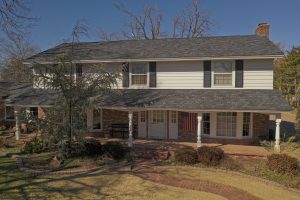What Is Roof Ventilation and Why Is It Important?
 Roof vents are an essential part of every home, yet many homeowners don’t know much about their roof ventilation system nor its function. So, to help spread knowledge about this important subject, here’s a roof ventilation guide from the Oklahoma roofing experts at McRoof.
Roof vents are an essential part of every home, yet many homeowners don’t know much about their roof ventilation system nor its function. So, to help spread knowledge about this important subject, here’s a roof ventilation guide from the Oklahoma roofing experts at McRoof.
All About Roof Ventilation
Your home’s roof ventilation system allows for air to flow through your attic space, and then out through the roof vents. This process creates a continuous flow of air thanks to the combined work of your roof’s intake vents and exhaust vents. Your home’s intake vents draw cooler outdoor air into the attic while your exhaust vents allow warm, humid air to escape out the top of your roof. This system helps prevent the buildup of excess heat and moisture in your attic which can have disastrous consequences for your home.
Effects of Improper Roof Ventilation
There are a plethora of issues an improperly ventilated roof may have. Here are just a few examples.
Excess Heat
If your home is exposed to excess heat without proper roof ventilation, several issues can occur. Heat can warp your roof sheathing and distort and prematurely age your shingles. Additionally, if your attic floor isn’t properly insulated, the trapped heat can radiate down into your home, raising the temperature. This makes it difficult to keep your home at a comfortable temperature and forces your HVAC to work extra hard, thus increasing the price of your energy bill.
Snow Dams
If you live in an area that experiences freezing temperatures, improper roof ventilation can wreak even more havoc on your home. When you run the heat in your home, warm air makes its way into the attic and rises to the underside of your roof deck. When your roof deck warms, accumulated snow melts, slides down, and then refreezes along the eaves of your roof. This creates an “ice dam” that prevents moisture from running off your roof, allowing water to accumulate underneath your shingles and damage them. With proper roof ventilation and insulation, this issue can be avoided.
Humidity and Moisture
When a roof is not properly ventilated, humidity from your living area or the outdoors can meet cool air in the attic and form condensation. This buildup of moisture in your attic can cause several severe issues. Your roof system and interior structural elements can be weakened or rotted away thanks to the damp conditions, and your insulation can get ruined too. The presence of moisture also creates the perfect environment for harmful mold and mildew to grow.
How to Spot Roof Ventilation Issues
By now, we’ve established that an improperly ventilated roof is a big problem. But how can a homeowner determine if they have roof ventilation issues? Here are a few signs to watch out for:
- An increase in your heating and cooling bills
- More frequent issues with your HVAC
- The formation of ice dams in the winter
- Noticeable roof warping
- Rust in your attic
- Water stains or visible decay on your roof’s structural supports
- Increased allergy symptoms or respiratory issues
If you suspect that your home has ventilation issues, it’s best to get a roof inspection from a trusted contractor like McRoof. We’d be happy to visit your home and provide an assessment of your roof and its ventilation system. Contact us today to get started!

